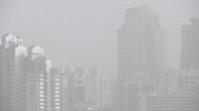Almost all of South Korea was on Wednesday shrouded by a yellow dust storm originating in the Gobi Desert in northern China and Mongolia, sending the country on a war-footing to cambat the environmental hazard that had hit the state severely after eight years.
The yellow storm had spread to almost all of the country as of 7 AM and will affect the entire nation until Thursday, according to the Korea Meteorological Administration (KMA). An advisory was issued for all parts of South Korea, Yonhap News Agency reported.

The average hourly concentration of fine dust particles smaller than 10 micrometers in diameter, known as PM 10, had risen to 192 micrograms per cubic meter in Seoul as of 7 a.m. and 494 micrograms in the city of Ulsan, 307 km southeast of Seoul, the KMA said.
A fine dust advisory is issued when the PM 10 figure stays above 150 micrograms for longer than two hours. The PM 10 density will remain at the "very bad" level in the rest of the country until Thursday, the KMA said.
In a related move, the Ministry of Environment said the second-lowest level of "caution" in the government's four-stage crisis alert against yellow dust was enforced for almost all parts of the country as of 7 a.m.

The authorities advised people with respiratory illnesses, the elderly and children to stay indoors, and use masks when going outside.
In 2015 too, the skyline of Seoul was covered through the haze of a sandy yellow dust blowing in from China. The Yellow dust, also known as Asian dust or yellow sand, is a meteorological phenomenon that affects many countries in East Asia, including South Korea.
It affects the region during the spring season when fine dust particles are blown from the Gobi and other deserts of China and Mongolia and carried by the prevailing winds to the Korean Peninsula and other nearby countries.
Often mixed with other pollutants, such as industrial emissions and vehicle exhaust, the storm leaves behind many people with respiratory problems. Whenever yellow dust levels are high, the people are advised to stay indoors and take precautionary measures.
In addition, the South Korean government has taken measures to monitor air quality, povide masks to vulnerable populations, and working with neighboring countries to address the root causes of the issue.
(With inputs from IANS)

















